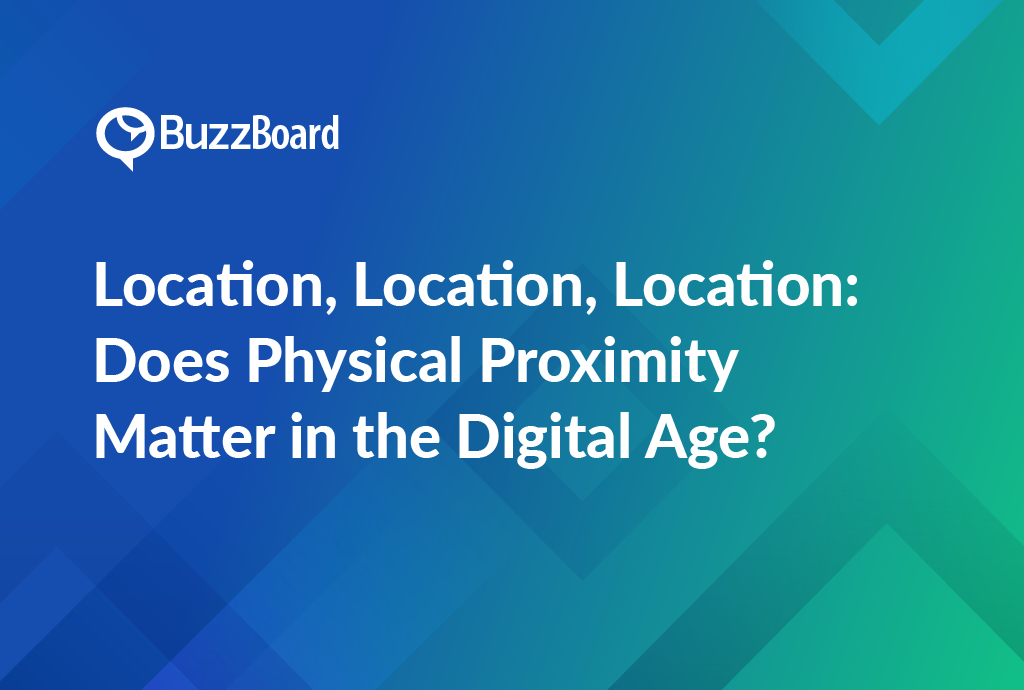Remote Digital Marketing and Working with Small Business
In the digital age, does physical proximity still matter? The answer is a resounding yes. Despite the rise of online interactions, physical location remains a crucial factor in many aspects of our lives. From local businesses to social connections, proximity plays a significant role in shaping our experiences. This article explores the importance of physical proximity in the digital age, highlighting how it affects our daily lives, from finding local services to building meaningful relationships. Discover how physical proximity continues to influence our lives, even in the digital era.
Understanding how Remote Digital Marketing is Transforming Small Business
In the technologically advanced age of today, remote digital marketing is revolutionizing the way small businesses operate, thrive, and succeed. Regardless of whether it’s a startup or a small-scale enterprise, businesses are progressively embracing this new norm—leveraging tools for remote collaboration and strategies for digital marketing to transcend geographical boundaries and target customer demographics globally.
Yet, a key question remains: does location still matter? Historically, business marketing strategies revolved around the business locale and consumers’ proximity and preferences. However, in the era of remote digital marketing, one needs to underscore that the physical location has become largely irrelevant.
The ever-evolving landscape of digital marketing presents numerous challenges for businesses, particularly those with a globally dispersed client base. One of the primary hurdles lies in navigating the complexities of time zones, which requires a sophisticated approach to scheduling and content delivery. To overcome this obstacle, successful digital marketing professionals rely on advanced scheduling tools and strategies that enable them to deliver targeted content at optimal times, taking into account the diverse time zones of their global clientele.
In addition to managing time zones, businesses must also adapt to the shifting preferences of their consumers. The way people communicate has undergone a significant transformation, with the rise of digital platforms and social media. As a result, businesses must modify their messaging, tone, and style to resonate with their audience. This involves understanding the cultural nuances that shape consumer behavior and preferences, and tailoring their advertising strategies accordingly. By doing so, companies can build stronger relationships with their global clientele, enhance their brand image, and foster loyalty.
To facilitate remote digital marketing, businesses have turned to advanced collaboration tools that enable seamless communication and project management. These tools, which include project management software, online meeting platforms, and cloud-based solutions, have become the foundation of successful remote digital marketing. By leveraging these technologies, businesses can streamline their operations, increase productivity, and deliver high-quality results.
For small businesses looking to implement remote digital marketing, it is essential to stay informed about the latest trends and best practices. Our comprehensive guide provides valuable insights and practical advice on how to navigate the complexities of remote digital marketing. By following our blog, you can stay up-to-date with the latest digital marketing trends and tips, and gain the knowledge and strategies needed to succeed in this rapidly evolving field.
The key to flourishing in remote digital marketing lies in understanding, adapting, and leveraging the emerging trends and technologies that shape this landscape. To stay ahead of the curve, it is essential to constantly explore and implement innovative strategies. By doing so, you can build a strong online presence, drive business growth, and establish your company as a leader in the digital marketing space.
Remote digital marketing presents a unique set of challenges and opportunities for businesses. By understanding the complexities of time zones, adapting to changing consumer preferences, and leveraging advanced collaboration tools, businesses can build a strong foundation for success. By staying informed about the latest trends and best practices, and constantly exploring and implementing innovative strategies, businesses can thrive in this rapidly evolving landscape and achieve their goals.
How Geographical Location Impacts Remote Digital Marketing Tactics
The geographical location plays a pivotal role in remote digital marketing for small businesses, extending far beyond simply adapting ad copy to align with regional slang or local customs. While technology has enabled us to transcend physical boundaries and conduct business globally 24/7, it is essential to acknowledge the practical considerations that cannot be ignored. From time zone differences to cultural comprehension, location is a vital component in remote digital marketing.
For salespeople navigating the digital marketing landscape, understanding how time zone disparities impact their marketing strategies is crucial. When planning social media posts, newsletters, or promotional efforts, it is vital to sync with the online activity schedules of the target consumers. This requires a deep understanding of the target audience’s daily routines, habits, and preferences, as well as the time zones they operate in. For instance, if your target audience is primarily based in Europe, you may need to adjust your marketing schedule to accommodate their morning commute or lunch break. Conversely, if your target audience is based in the Americas, you may need to adjust your schedule to accommodate their evening routines.
Another critical aspect of effective remote digital marketing tailored to specific geographical locations is the use of remote collaboration tools. Tools such as Slack, Trello, or Asana make it possible for teams across different locations to collaborate effectively, ensuring brand consistency regardless of team members’ location. This is particularly important when working with international teams or freelancers, as it enables seamless communication and coordination. By leveraging these tools, teams can work together in real-time, share files, and track progress, all while maintaining a consistent brand voice and message.
Beyond operational aspects, having a comprehensive cultural awareness is vital in remote digital marketing. Your brand messaging, visuals, and communication preferences must resonate with the local audience’s culture, fostering a significant connection to encourage long-term brand loyalty. This requires a deep understanding of the local culture, including its values, norms, and customs. For instance, if you are targeting a predominantly Asian market, you may need to incorporate elements of Confucianism, such as respect for authority and tradition, into your marketing strategy. Conversely, if you are targeting a predominantly Western market, you may need to emphasize individualism and personal freedom.
It is also essential to consider how you represent your agency to different audience segments across locales. This requires a nuanced understanding of the local audience’s preferences, behaviors, and pain points. For instance, if you are targeting a predominantly urban audience, you may need to emphasize the convenience and accessibility of your product or service. Conversely, if you are targeting a predominantly rural audience, you may need to emphasize the value and practicality of your product or service.
Geographical location plays a significant role in remote digital marketing for small businesses. It is essential to consider time zone differences, cultural comprehension, and operational aspects when developing a marketing strategy. By leveraging remote collaboration tools, understanding cultural nuances, and adapting to local preferences, small businesses can effectively navigate the digital marketing landscape and achieve long-term success.
Time Zone Differences and Their Effect on Remote Digital Marketing
In today’s interconnected and rapidly evolving digital landscape, small businesses operating in the remote digital marketing space must be aware of the significant impact that time zone differences can have on their strategies and workflows. As the world becomes increasingly globalized and digitized, it is crucial for small businesses to navigate the complexities of time zone differences to ensure seamless communication, effective project management, and successful marketing campaigns.
The traditional notion that “location matters” is no longer sufficient in the era of remote digital marketing. Instead, small businesses must contend with the reality that time zone differences can significantly influence their operations. The geographical boundaries that once defined marketing efforts have dissolved in the virtual world, and small businesses must adapt to this new reality.
Time zone differences can present significant challenges, particularly when it comes to communication preferences. Maintaining consistent, real-time communication can be problematic, especially when working with teams or clients across different time zones. However, overcoming these challenges is achievable with the help of advanced remote collaboration tools. Tools such as Asana, Trello, or Slack can streamline project management, facilitate seamless communication, and synchronize workflows across different time zones.
Moreover, acknowledging time zone differences can lead to a deeper understanding of cultural subtleties. A profound appreciation of cultural nuances can translate into more powerful, context-specific marketing messages that resonate with diverse audiences. By recognizing the importance of cultural differences, small businesses can tailor their marketing strategies to effectively engage with customers from various regions and backgrounds.
To successfully navigate the complexities of time zone differences, small businesses must prioritize continuous education and awareness of the latest trends in remote digital marketing. This includes staying up-to-date with the latest tools, technologies, and best practices that can help mitigate the challenges posed by time zone differences.
In addition to understanding the impact of time zone differences, small businesses must also develop strategies to effectively manage these differences. This may involve:
- Establishing clear communication protocols: Set clear expectations for communication, including the frequency and timing of updates, to ensure that all team members are on the same page.
- Utilizing time zone-friendly tools: Leverage tools that are designed to accommodate different time zones, such as project management software that allows for real-time collaboration and communication.
- Building a flexible workflow: Develop a flexible workflow that can adapt to different time zones and schedules, allowing for seamless collaboration and communication.
- Fostering a culture of adaptability: Encourage a culture of adaptability and flexibility within your team, recognizing that time zone differences can present challenges and opportunities for growth.
- Prioritizing cultural awareness: Develop a deep understanding of cultural differences and nuances, recognizing that these differences can have a significant impact on marketing strategies and customer engagement.
By acknowledging the impact of time zone differences and developing strategies to effectively manage these differences, small businesses can enhance their remote digital marketing capabilities, improve communication and collaboration, and ultimately drive business success. Remember, navigating time zone differences is an acquirable skill that requires continuous education, awareness, and adaptability.
The Importance of Remote Collaboration Tools and Effective Communication when Dealing with Different Locations
It’s become increasingly crucial for digital marketing salespeople to adapt to the growing importance of remote digital marketing for small businesses. One of the key factors that can make or break success in this arena is the ability to skillfully manage different time zones and navigate the complexities of global communication. This age-old question arises: does location still matter in the digital age?
The answer is a resounding no. Remote collaboration tools have revolutionized the way we work, making location virtually irrelevant. These tools have become an integral part of many business operations, recognized for their ability to bridge geographical divides and facilitate seamless communication. By leveraging platforms such as Slack for communication and Asana for project management, your team can operate efficiently, ensuring that distance, time, and location are no longer barriers to creating successful business relationships.
However, beyond the logistical advantages these tools provide, there is an often-overlooked aspect that can significantly impact the success of remote digital marketing: communication preferences. A firm grasp of conventional protocol and language subtleties can make all the difference in effective communication. This understanding, when combined with a comprehensive cultural appreciation, can lead to superior engagement with both clients and colleagues.
In today’s globalized digital marketplace, it’s essential to recognize that cultural diversity and sensitivity are critical components of successful remote collaboration. Without a deep understanding of the cultural nuances that shape communication styles, global collaborations can still prove challenging, even with the most sophisticated tools at your disposal.
To harness the power of remote digital marketing, it’s essential to develop a mindset that acknowledges and respects the diversity within your team and client base. This means being aware of the cultural differences that can impact communication, such as language barriers, time zone differences, and varying levels of technological proficiency.
By adopting a culturally sensitive approach to remote digital marketing, you can build stronger relationships with clients and colleagues, foster greater collaboration, and ultimately drive business success. To learn more about successful global collaborations, explore resources such as [insert resources], which offer valuable insights and best practices for navigating the complexities of remote digital marketing.
In the digital age, it’s not the ‘where’ that matters, but the ‘how effectively you communicate’ that truly counts. By leveraging remote collaboration tools, developing a culturally sensitive approach, and prioritizing effective communication, you can gain a competitive edge in the global marketplace and drive success for your small business.
The Role of Cultural Understanding in Remote Digital Marketing for Small Businesses
The concept of “remote digital marketing for small businesses” has taken on new significance. As sales professionals, it is no longer sufficient to simply examine the demographics of our target audience. We must also delve deeper to understand their cultural nuances, values, and behaviors to plan effective digital marketing campaigns that resonate with them. The cultural aspect of marketing is often overlooked, but it is a crucial factor that can make or break the success of a campaign.
One of the key considerations in remote digital marketing is the impact of time zone differences on customer engagement. While it is true that time zones can provide the potential for continuous customer engagement, it is essential to discern peak online activity times that are influenced by cultural and lifestyle habits. For instance, in some cultures, people may be more active online during certain hours of the day or night, while in others, online activity may be more sporadic. Understanding these patterns is critical for meaningful customer interactions and building strong relationships with our target audience.
Another critical aspect of remote digital marketing is the use of remote collaboration tools. These tools, such as Google Docs, Trello, and Slack, enable real-time collaboration from diverse geographical locations, promoting the sharing of cultural insights and ensuring that the team aligns with a common marketing goal while understanding cultural implications. By leveraging these tools, we can create culturally precise marketing messages that resonate with our target audience and avoid cultural faux pas that can damage our brand reputation.
Communication preferences can also substantially differ based on culture. Some cultures may favor direct and formal methods like emails, while others may be more responsive to informal channels like social media platforms or chat apps. This highlights the importance of a strategically localized communication plan that takes into account the cultural preferences of our target audience. By using the right communication channels and tone, we can build trust and credibility with our audience, increasing the likelihood of successful marketing campaigns.
Cultural understanding is a vital tool for “remote digital marketing for small businesses.” It assists in fully understanding the consumer, creating impactful messages, navigating time zone differences, effectively using remote collaboration tools, and catering to local communication preferences. By integrating cultural understanding into our digital marketing strategy, we can create campaigns that are more effective, more engaging, and more successful.
So, how can you integrate cultural understanding into your digital marketing strategy? Here are a few tips:
- Conduct cultural research: Research the cultural nuances, values, and behaviors of your target audience to gain a deeper understanding of their preferences and behaviors.
- Use remote collaboration tools: Leverage tools like Google Docs, Trello, and Slack to promote real-time collaboration and sharing of cultural insights.
- Discern peak online activity times: Understand the peak online activity times of your target audience and plan your marketing campaigns accordingly.
- Create culturally precise marketing messages: Use cultural insights to create marketing messages that resonate with your target audience and avoid cultural faux pas.
- Develop a strategically localized communication plan: Use the right communication channels and tone to build trust and credibility with your audience.
- Monitor and adjust: Continuously monitor the performance of your marketing campaigns and adjust your strategy as needed to ensure that it is effective and culturally relevant.
By following these tips, you can integrate cultural understanding into your digital marketing strategy and create campaigns that are more effective, more engaging, and more successful.
Conclusion
In today’s digital age, the age-old adage “location, location, location” may seem outdated. However, the article “Location, Location, Location: Does Physical Proximity Matter in the Digital Age?” reveals that physical proximity still plays a significant role in various aspects of our lives. While technology has enabled remote work, online shopping, and social media connections, it has not eliminated the importance of physical proximity.
The article highlights that physical proximity can have a profound impact on our mental and physical well-being, social connections, and economic opportunities. For instance, living in a densely populated area can lead to increased social interaction, improved mental health, and access to job opportunities. On the other hand, living in a remote or isolated area can lead to feelings of loneliness, decreased social connections, and limited job prospects.
Moreover, the article emphasizes that physical proximity is not just about personal relationships but also about business and economic growth. Proximity to markets, suppliers, and customers can significantly impact a company’s success, making it easier to collaborate, innovate, and adapt to changing market conditions.
In conclusion, while technology has certainly changed the way we live and work, physical proximity remains a crucial factor in our lives. As we navigate the digital age, it is essential to recognize the importance of physical proximity in shaping our social connections, mental and physical well-being, and economic opportunities. By acknowledging the value of physical proximity, we can create more inclusive, connected, and prosperous communities that thrive in the digital age.









